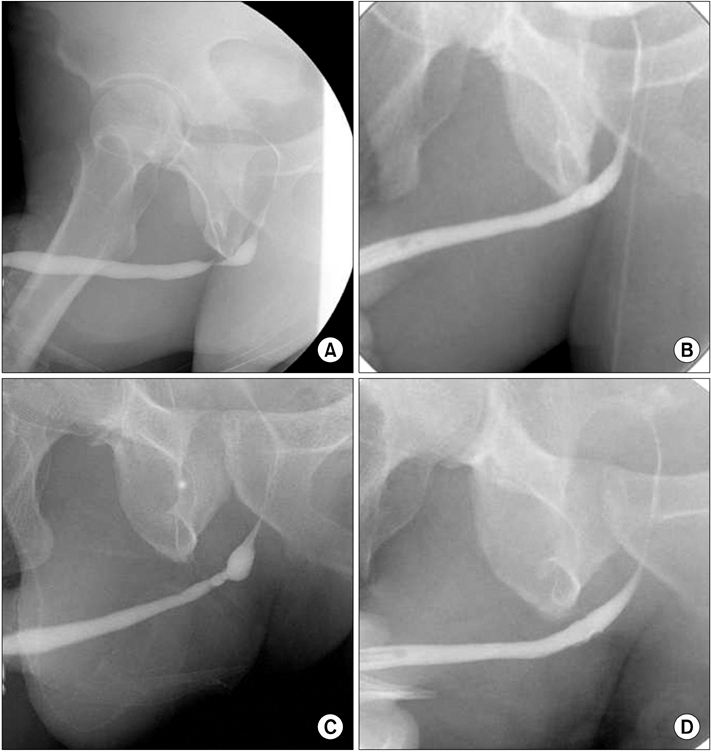Korean J Urol.
2013 Jul;54(7):442-447.
Surgical Outcome of Excision and End-to-End Anastomosis for Bulbar Urethral Stricture
- Affiliations
-
- 1Department of Urology, Seoul National University Hospital, Seoul, Korea. swkim@snu.ac.kr
Abstract
- PURPOSE
Although direct-vision internal urethrotomy can be performed for the management of short, bulbar urethral strictures, excision and end-to-end anastomosis remains the best procedure to guarantee a high success rate. We performed a retrospective evaluation of patients who underwent bulbar end-to-end anastomosis to assess the factors affecting surgical outcome.
MATERIALS AND METHODS
We reviewed 33 patients with an average age of 55 years who underwent bulbar end-to-end anastomosis. Stricture etiology was blunt perineal trauma (54.6%), iatrogenic (24.2%), idiopathic (12.1%), and infection (9.1%). A total of 21 patients (63.6%) underwent urethrotomy, dilation, or multiple treatments before referral to our center. Clinical outcome was considered a treatment failure when any postoperative instrumentation was needed.
RESULTS
Mean operation time was 151 minutes (range, 100 to 215 minutes) and mean excised stricture length was 1.5 cm (range, 0.8 to 2.3 cm). At a mean follow-up of 42.6 months (range, 8 to 96 months), 29 patients (87.9%) were symptom-free and required no further procedure. Strictures recurred in 4 patients (12.1%) within 5 months after surgery. Of four recurrences, one patient was managed successfully by urethrotomy, whereas the remaining three did not respond to urethrotomy or dilation and required additional urethroplasty. The recurrence rate was significantly higher in the patients with nontraumatic causes (iatrogenic in three, infection in one patient) than in the patients with traumatic etiology.
CONCLUSIONS
Excision and end-to-end anastomosis for short, bulbar urethral stricture has an acceptable success rate of 87.9%. However, careful consideration is needed to decide on the surgical procedure if the stricture etiology is nontraumatic.
MeSH Terms
Figure
Reference
-
1. Bullock TL, Brandes SB. Adult anterior urethral strictures: a national practice patterns survey of board certified urologists in the United States. J Urol. 2007; 177:685–690.2. Wright JL, Wessells H, Nathens AB, Hollingworth W. What is the most cost-effective treatment for 1 to 2-cm bulbar urethral strictures: societal approach using decision analysis. Urology. 2006; 67:889–893.3. Barbagli G, Palminteri E, Lazzeri M, Guazzoni G, Turini D. Long-term outcome of urethroplasty after failed urethrotomy versus primary repair. J Urol. 2001; 165(6 Pt 1):1918–1919.4. Rourke KF, Jordan GH. Primary urethral reconstruction: the cost minimized approach to the bulbous urethral stricture. J Urol. 2005; 173:1206–1210.5. Santucci RA, Mario LA, McAninch JW. Anastomotic urethroplasty for bulbar urethral stricture: analysis of 168 patients. J Urol. 2002; 167:1715–1719.6. Eltahawy EA, Virasoro R, Schlossberg SM, McCammon KA, Jordan GH. Long-term followup for excision and primary anastomosis for anterior urethral strictures. J Urol. 2007; 177:1803–1806.7. Barbagli G, De Angelis M, Romano G, Lazzeri M. Long-term followup of bulbar end-to-end anastomosis: a retrospective analysis of 153 patients in a single center experience. J Urol. 2007; 178:2470–2473.8. Yoon JS, Kim DY, Kim CI, Kim KS. A comparative study of visual internal urethrotomy and urethroplasty in the treatment of post-traumatic complete urethral stricture. Korean J Urol. 1997; 38:837–841.9. Mundy AR. Anastomotic urethroplasty. BJU Int. 2005; 96:921–944.10. Barbagli G, Guazzoni G, Lazzeri M. One-stage bulbar urethroplasty: retrospective analysis of the results in 375 patients. Eur Urol. 2008; 53:828–833.11. Mangera A, Chapple C. Management of anterior urethral stricture: an evidence-based approach. Curr Opin Urol. 2010; 20:453–458.12. Barbagli G, Palminteri E, Guazzoni G, Montorsi F, Turini D, Lazzeri M. Bulbar urethroplasty using buccal mucosa grafts placed on the ventral, dorsal or lateral surface of the urethra: are results affected by the surgical technique? J Urol. 2005; 174:955–957.13. Patterson JM, Chapple CR. Surgical techniques in substitution urethroplasty using buccal mucosa for the treatment of anterior urethral strictures. Eur Urol. 2008; 53:1162–1171.14. Guralnick ML, Webster GD. The augmented anastomotic urethroplasty: indications and outcome in 29 patients. J Urol. 2001; 165:1496–1501.15. Abouassaly R, Angermeier KW. Augmented anastomotic urethroplasty. J Urol. 2007; 177:2211–2215.16. El-Kassaby AW, El-Zayat TM, Azazy S, Osman T. One-stage repair of long bulbar urethral strictures using augmented Russell dorsal strip anastomosis: outcome of 234 cases. Eur Urol. 2008; 53:420–424.17. Jezior JR, Schlossberg SM. Excision and primary anastomosis for anterior urethral stricture. Urol Clin North Am. 2002; 29:373–380.18. Lindell O, Borkowski J, Noll F, Schreiter F. Urethral stricture repair: results in 179 patients. Scand J Urol Nephrol. 1993; 27:241–245.19. Buckley JC, Wu AK, McAninch JW. Impact of urethral ultrasonography on decision-making in anterior urethroplasty. BJU Int. 2012; 109:438–442.20. Singh O, Gupta SS, Arvind NK. Anterior urethral strictures: a brief review of the current surgical treatment. Urol Int. 2011; 86:1–10.21. Morey AF, Kizer WS. Proximal bulbar urethroplasty via extended anastomotic approach: what are the limits? J Urol. 2006; 175:2145–2149.22. Culty T, Boccon-Gibod L. Anastomotic urethroplasty for posttraumatic urethral stricture: previous urethral manipulation has a negative impact on the final outcome. J Urol. 2007; 177:1374–1377.23. Yucel S, Baskin LS. Neuroanatomy of the male urethra and perineum. BJU Int. 2003; 92:624–630.24. Mundy AR, Andrich DE. Urethral strictures. BJU Int. 2011; 107:6–26.25. Kessler TM, Fisch M, Heitz M, Olianas R, Schreiter F. Patient satisfaction with the outcome of surgery for urethral stricture. J Urol. 2002; 167:2507–2511.26. Jackson MJ, Sciberras J, Mangera A, Brett A, Watkin N, N'dow JM, et al. Defining a patient-reported outcome measure for urethral stricture surgery. Eur Urol. 2011; 60:60–68.
- Full Text Links
- Actions
-
Cited
- CITED
-
- Close
- Share
- Similar articles
-
- Experience of 191 Cases of Urethral Rupture and Stricture
- Clinical Observations on Urethroplasty in Urethral Injury
- Two cases of primary urethral end to end anastomosis for posterior urethral rupture
- A Clinical Observation on Urethroplasty in 49 Cases with Urethral Injury
- Penile Dorsal Skin Flap Urethroplasty in Extensive Traumatic Urethral Stricture


